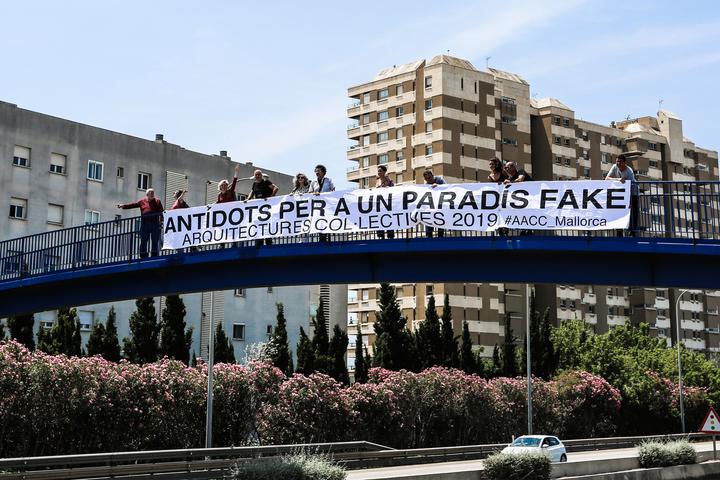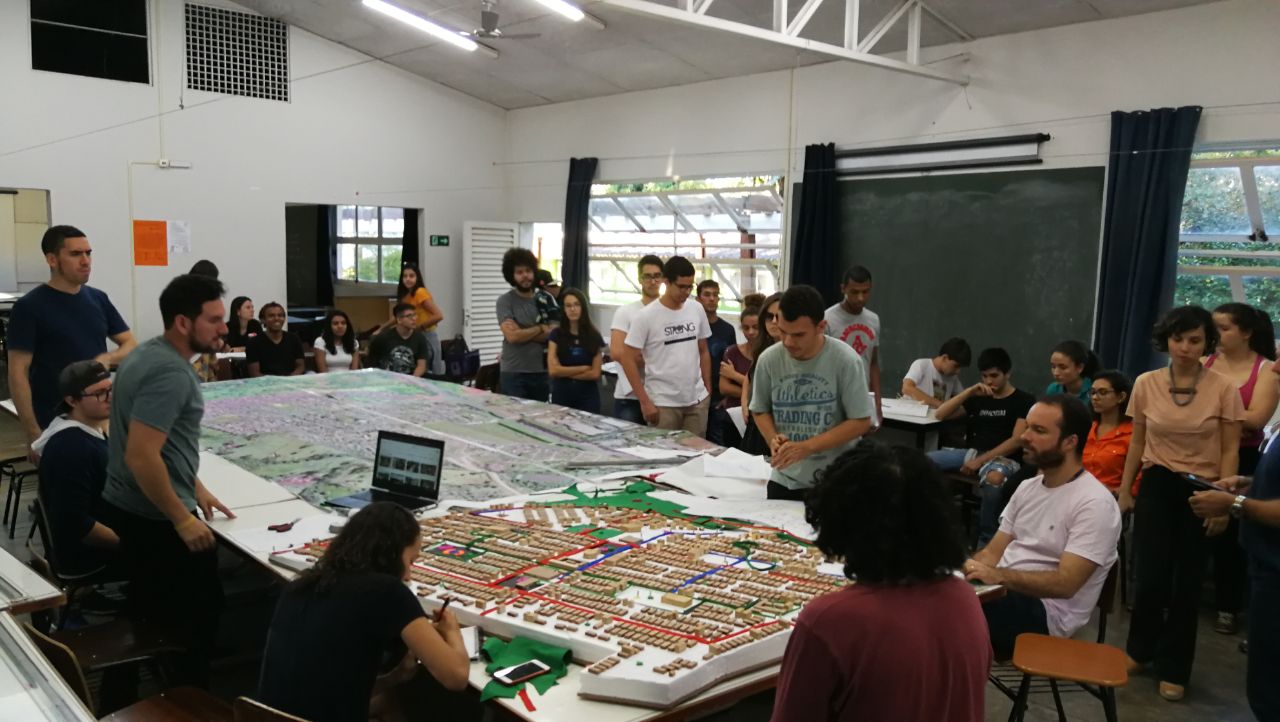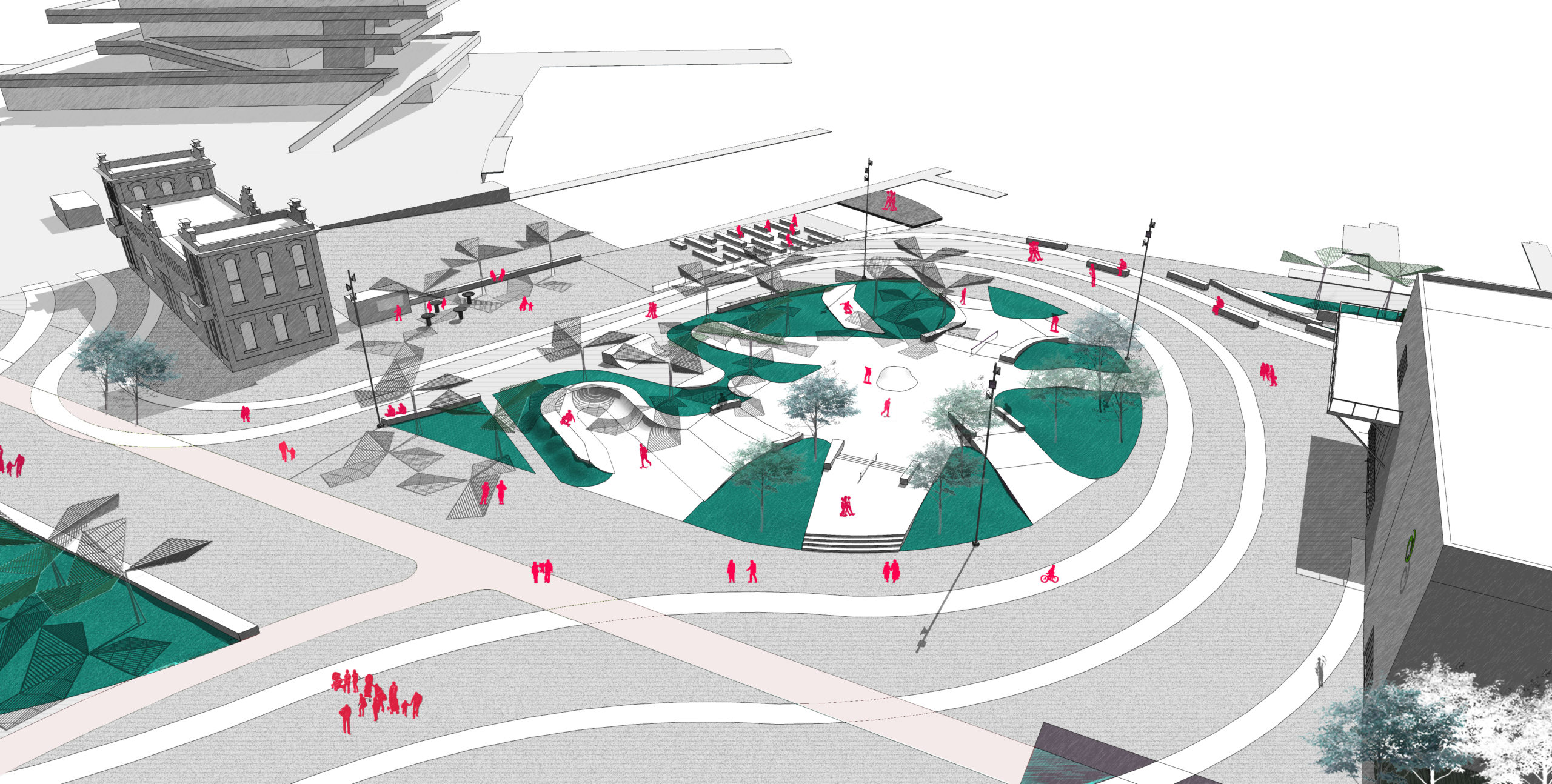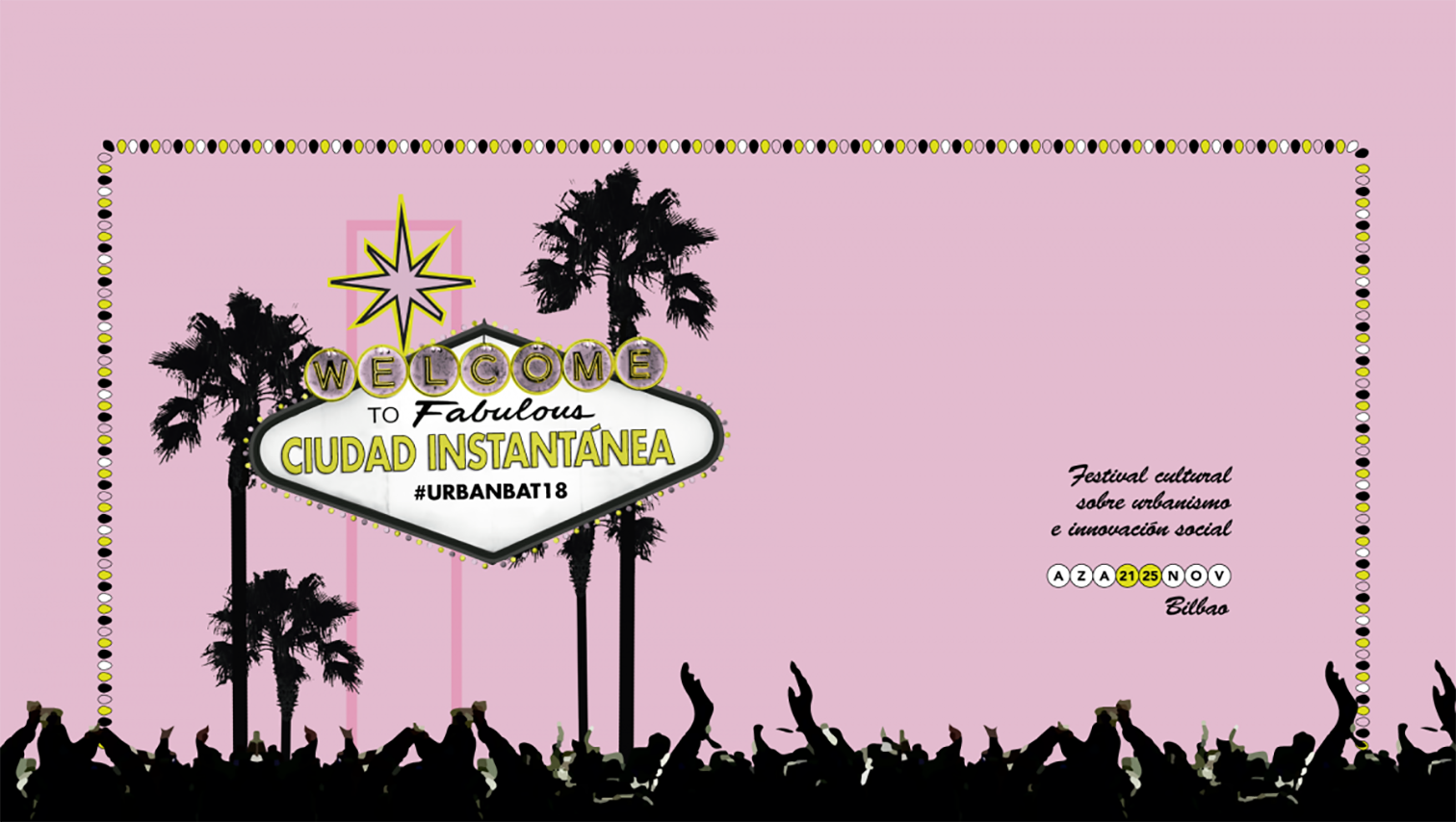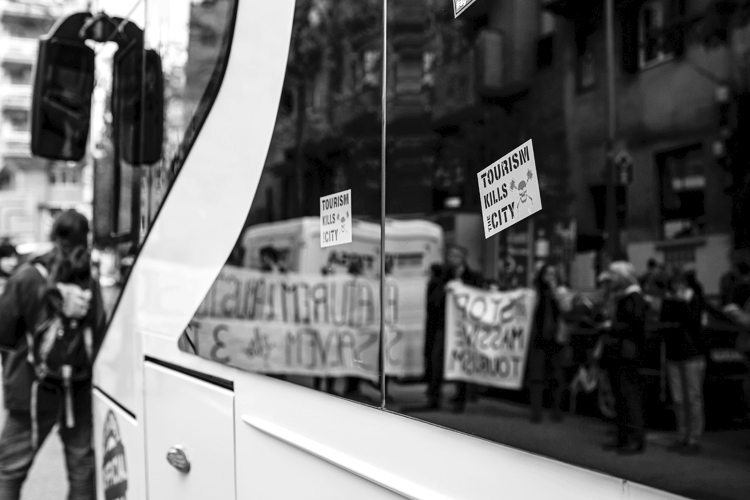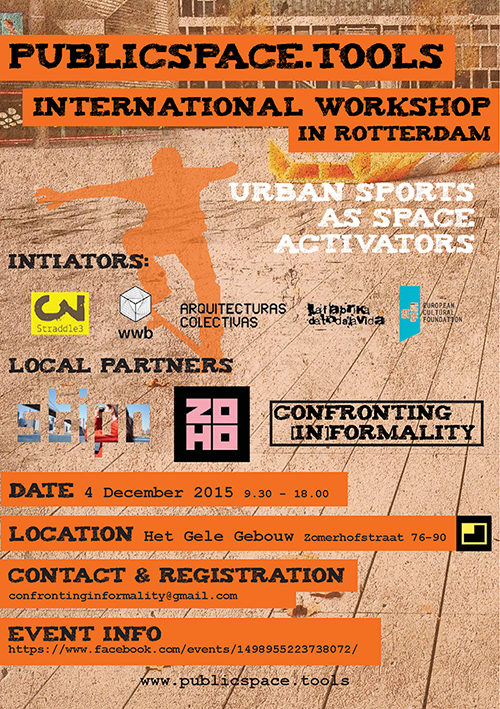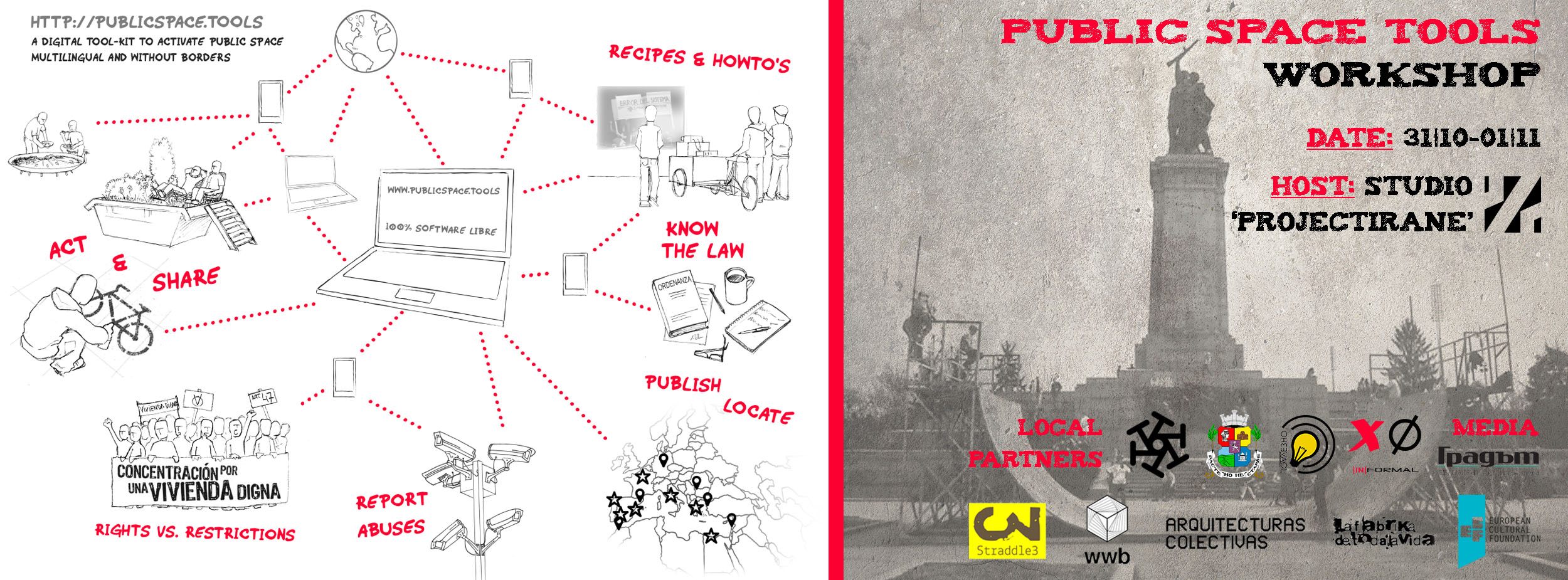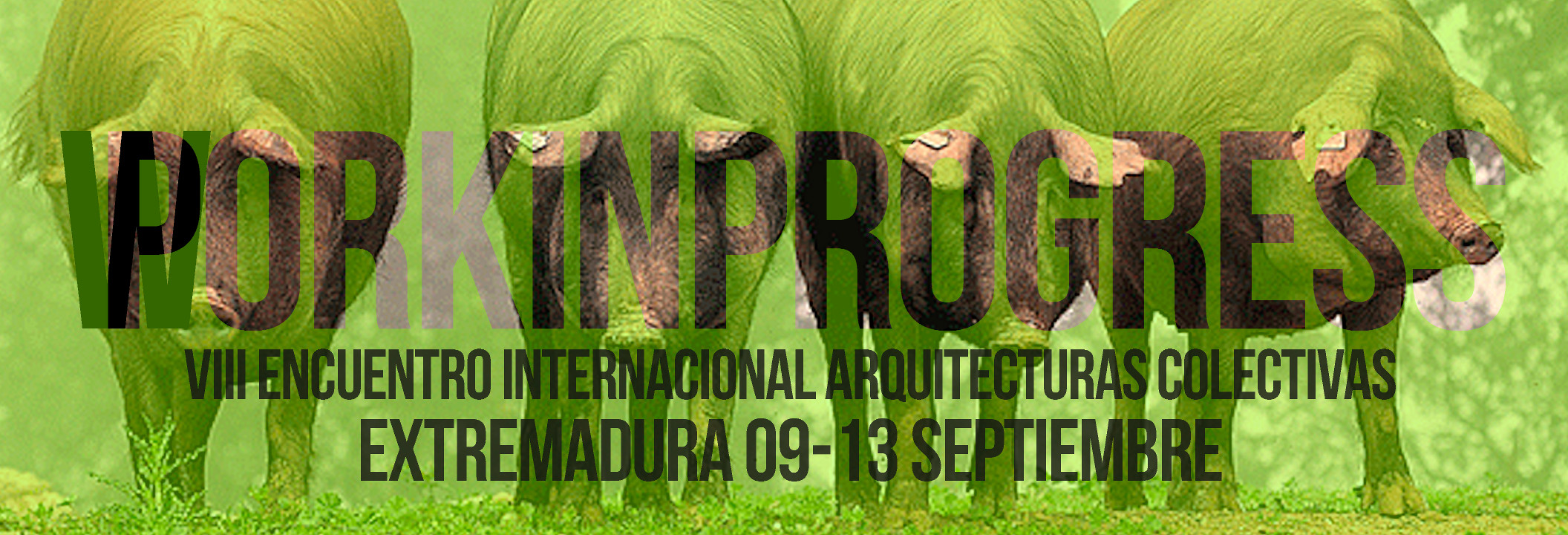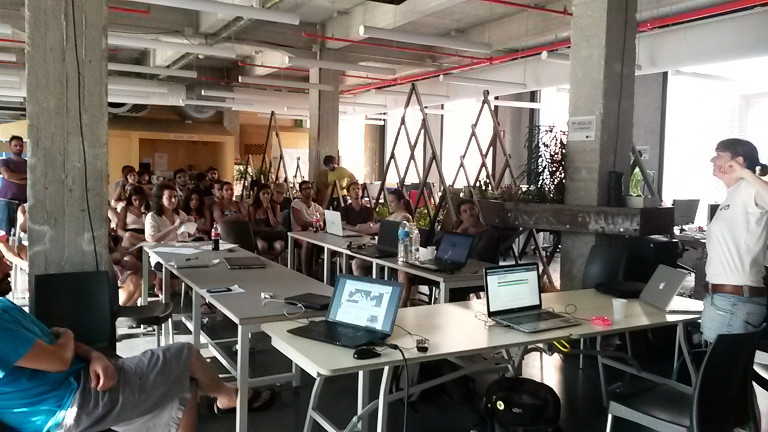Los organizadores de las jornadas, que tendrán lugar del 25 al 29 de septiembre, desplegaron este miércoles una pancarta desde el puente sobre la autopista que une Nou Llevant y Molinar para escenificar su objetivo, que es plantear unas prioridades para la mejora de la zona en transformación. ‘Antídotos para un paraíso fake’ es el lema que se podía leer en este gran cartel de la red Arquitecturas Colectivas.
Category: Blog
A Lecture On “Practical Democracy: Space And Society” By David Juarez In Uberaba University, Brazil
“III Symposium and International Workshop: [Re] think the democratic space – Architecture + City”, was held between 20-24 May 2019 in the campus of Uberaba University with the participation of students and professors of the Architecture and Urbanism department and professionals from different disciplines and countries; architects Horacio Cherniavsky (Paraguay), José Fernando Gomez Marmolejo (Ecuador), David Juarez (Spain), Nabil Bonduki (Brazil), filmmaker André Fratti Costa (Brazil) and philosopher Imaculada Kangussu (Brazil).
The symposium featured a workshop, lectures and thematic discussion tables on the subject “Re-existing”, reflecting on different ways to face contemporary urban problems and exchanging academic experiences. On 22.05.2019 David Juarez contributed with a lecture about “Practical democracy: space and society”.
The symposium came to an end with the presentation of the workshop results on the Alfredo Freire neighborhood 1. During the workshop, students engaged in creating cohesive solutions on projects spanning landscape and architecture design as well as audiovisual production. The workshop tackled social and spatial exclusion during the process of peripherization in Uberaba, specifically focusing on a housing complex built in 1983 at the “edge” of the city, which is currently in the sixth phase of expansion. The professionals who took part in the symposium, reflected on the enriching influences of knowledge and experience exchange that come from different countries.
“The theme of this workshop contains as much potential as it contains problems. By bringing people from different backgrounds together, we are making the focus much more diverse. The issue at hand is being analysed from various angles and thus all these different profiles are complementing each other, bringing students into a far richer and more entertaining vision.” David Juarez
“Although they are all related to architecture, the practices, methodologies, ways of relating to the object and to the city may be different. So bringing guests from outside allows us to reflect on the bigger picture so that the students understand and stimulate new perspectives, possibilities and can articulate new fields of design, language and learn a little of the culture and history of the guests.” Thiago Reis, professor of Architecture at Uberaba
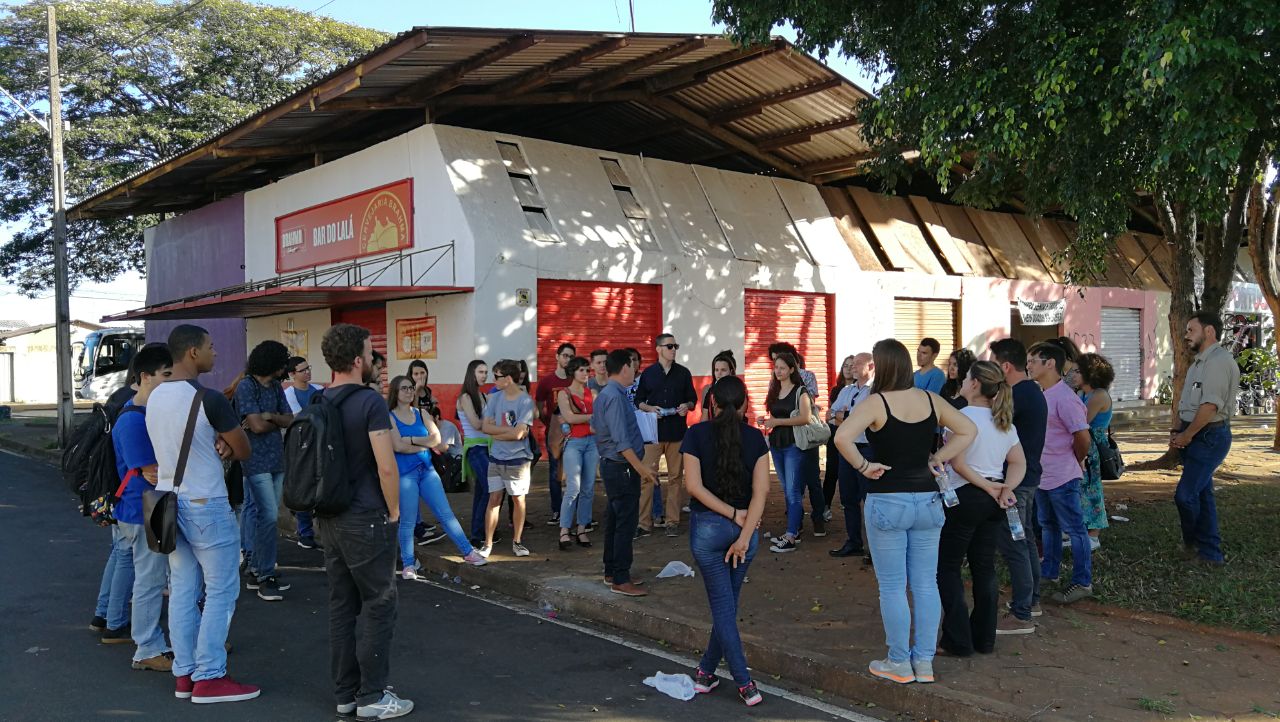
“Urban Marsh” wins the ideas contest for the La Ona plaza in Valencias Marina
“Urban Marsh” has won the Ideas contest with the proposal of a singular and inclusive space, with green and shaded areas, a kiosk, an auditorium, a viewpoint and different citizen uses distributed in hills around a skating rink.
The project idea contemplates that part of the design phase of skatepark and public space elements be carried out through participatory workshops.
To learn more about the project click the link below:
https://straddle3.net/es/proyectos/marjal-urbana
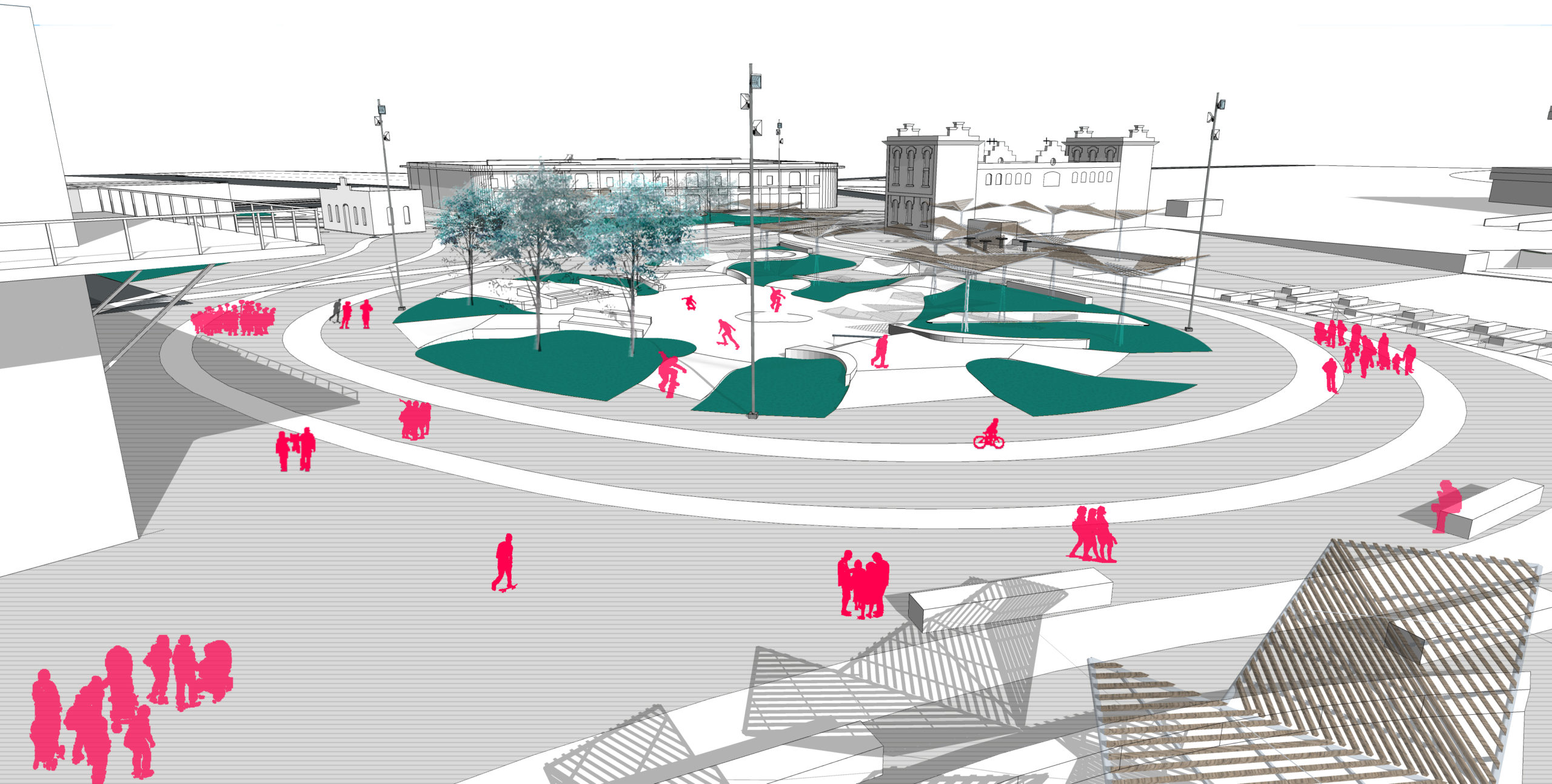
7º Festival URBANBAT. CIUDADES INSTANTÁNEAS
Bajo el nombre de CIUDADES INSTANTÁNEAS, esta edición del festival cultural de urbanismo e innovación social tratará sobre el fenómeno de los grandes eventos, su relación con las estrategias de planificación urbana, su impacto sobre el paisaje, la economía y la cultura local e invita a profesionales de la gestión urbana, arquitectos, urbanistas, instituciones, investigadores, agentes sociales y promotores de eventos a diseñar estrategias compartidas que garanticen un equilibrio para el entorno y el beneficio para la comunidad local.
Hemos preparado la programación del festival como un laboratorio abierto a toda la ciudadanía, como un proceso de investigación y acción que se desarrollará en distintos formatos: charlas, espacios de networking, rutas, exposiciones, actividades artísticas…
L’anticiutat o la vida
The North American urbanist and historian Lewis Mumford, author of the colossal work The City in History (1961), described a new phenomenon: the spread of suburbia across the length and breadth of the United States in the fifties, in order to house a growing white, salaried middle class. He was not talking about brand new cities or about the expansion of existing ones, but about a new type of dispersed urbanisation scattered throughout the land, connected by huge road networks but lacking urban centres or shared identities.
Mumford – and some of his followers, including Murray Bookchin – believed that this new megalopolis was becoming a force of social and even mental segregation, which denied any possibility of the city as cultural project, breaking down public and the social spaces of gathering and conflict. As urban developments without the characteristics of a city, these new mass residential suburbs on a mass scale where an “anti-city”, Mumford said. They were created for the purpose of containing undifferentiated, indifferent lives. They were incapable of generating community or association, incapable of producing city.
A few decades later, the French anthropologist Marc Augé coined the concept of “non-places” as a spatial category for postmodern times. “Non-places” are spaces of transience or waiting such as airport lobbies, underground stations, ATM and supermarket queues. Users have a purely contractual relationship with these spaces, and their commercial solitude makes it impossible for them to inhabit them, to turn space into place.
Now, the evolution of metropolitan mode of production is going one vertiginous step further: the categories of the anti-city and non-places are shifting from the margins to the centre, and materialising with disturbing propinquity.
The Capitalist Totalisation of Space
Indeed, the anti-city is no longer a phenomenon that occurs outside the city. Instead, it pierces the city, it sucks it dry from within. Similarly, non-places are now not just aseptic, anodyne hotel terminals and stations; they have moved into the heart of former working-class neighbourhoods that had until recently been vibrant and full of people. Hotels and tourist apartments are replacing housing – homes – on a mass scale. New economic activities targeted at a floating population of tourists are transforming urban production: laundromats with invisible staff, rolling suitcases rather than shopping trolleys, coffees for four euros, signs outside shops in English “wifi and cookies home made”.
Local residents are expelled from the neighbourhoods that they themselves created through their everyday activities and collective struggles. Their presence is only accepted – if they are lucky – as temporary employees in the new “extreme precarity”. People’s lives and jobs are replaced by transience and by activities that are indifferent to the environment, by users with a purely “contractual relationship with the space”. Working-class neighbourhoods are being erased by an active force of social dissociation that repels community and association. The entire city is at risk of becoming a huge hotel, a massive airport, a humongous vending machine, an infinite terminal, a monopoly board for investors.
Nonetheless, anti-cities and non-places are an accidental reality, the result of one particular kind of economy, one specific form of capitalist production of space. And they are the spatial condition that is becoming widespread in the new tourism-property accumulation regime – a post-crisis systemic restructuring in which tourism replaces bricks and mortar (or the tourism industry replaces construction) as the means to intensify the rent-seeking and speculation of urban land. In this regime, financial and property capital (as well as technological capital – damned Airbnb) determines the destination of investments as well as the structure and distribution of income. As the president of a Barcelona-based French investment group said: “There is a huge stock of housing intended as first or second residences that the market is unable to absorb, and we have turned it into apartments,” (Gutiérrez, S. “El turisme salva el totxo”, El Periódico, 10 April 2014). This new profit-hungry accumulation regime seeks the capitalist totalisation of urban space.
A New Cycle of Struggles for Urban Collectivisation
Staving off the anti-city and the spread of non-places in order to reempower the city – and life – requires a direct attack against the tourism-property accumulation regime We need to activate a new alliance of popular, socioeconomic, feminist, and environmental movements that can defend urban grassroots sectors against the attack of tourism-property capital. Neighbourhood associations, community facilities, social and solidarity economy initiatives, local and mutual support networks, undocumented migrant associations, organisations of people affected by extreme precariousness, and new social unions must join together and continue on the path taken by anti-eviction movements, activate joint mobilisations, conquer new spaces, and work to ensure that municipal and autonomous community governments are at the service of urban social reappropriation.
So if we want our city to be the fruit of the desires and needs of the people who live in it, a city at the service of the expanded reproduction of life, we must urgently move towards the collectivisation of land ownership in all possible modalities: nationalisation, municipalisation, cooperativisation, socialisation, squatting, citizen control. It is becoming increasingly clear that urban collectivisation and reappropriation are the only means that will allow us to realize our plan for a cooperative, mutually supportive, feminist city.
Tomorrow will be too late.
*Ivan Miró is a sociologist and cooperativist. This article was published in Basque in Argia.
Public Space Tools Workshop @ Rotterdam (04|12)
Place-making, citizen empowerment and the right to city are concepts which have grown in popularity during the last decade. In the Dutch context multiple design collectives and companies within the fields of planning and (landscape) architecture have focused on utilising the aforementioned concepts in order to facilitate the urban development in 21st century.
In order to work on these topics and, more specifically, the idea of PublicSpace.tools platform, a one-day workshop has been organised on 4th December in Rotterdam. The host and a local partner of the event was Stipo – an urbanism office that operates as innovators, initiators, developers and project managers of urban development schemes. The workshop was specifically focused on the theme of urban sports and more precisely, on urban skating as public space activators. Skating seems to have a direct relationship with the public space, the empowerment of citizens and legal issues. At the same time the theme allows the event to go in a certain direction and provides some useful, at least modest, input for the platform.
For the purpose of the workshop the schedule was organised in a specific way defining three main parts. The morning session of the workshop consisted of three interactive presentations which aimed to provide the participants with the possibility of getting familiar with (1) the main concepts of interest that are behind the platform development and (2) the practical experience of Stipo (NL) and Straddle3 (ES). In the early afternoon a public safari, led by skater Niels van der Zwam, was made. It aimed to bring the participants to some of the most emblematic skating spots in Rotterdam. The last part of the workshop focused on the technicalities and possibilities of the PublicSpace.tools platform and practical knowledge concerning the legal norms in respect to public space in the Netherlands.
Presentational Part
The morning session of the event consisted of three presentations made by Sander van der Ham (Stipo), David Juarez (Straddle3), Ale González (WWB) and Sergi Arenas. The introduction of the event was made by Sander van der Ham who is a representative of our host – Stipo. Sander shared some of the perspectives which stay behind the philosophy of Stipo and their inspiring approach towards public space intervention(s).
The next set of presentations was made by David Juarez (co-founder of Straddle3) together with Sergi Arenas and Ale González who are some of the main initiators behind the PublicSpace.tools project. First of all David introduced the participants into the theme of public space essence, its dynamics, specifics of the various uses, the “right to city” concept and legal issues in respect to it. Later on he was joined by Sergi Arenas with whom David presented their main practical experiences in working with urban skating development from organisation of collaboratively efforts to the actual execution of the construction works.
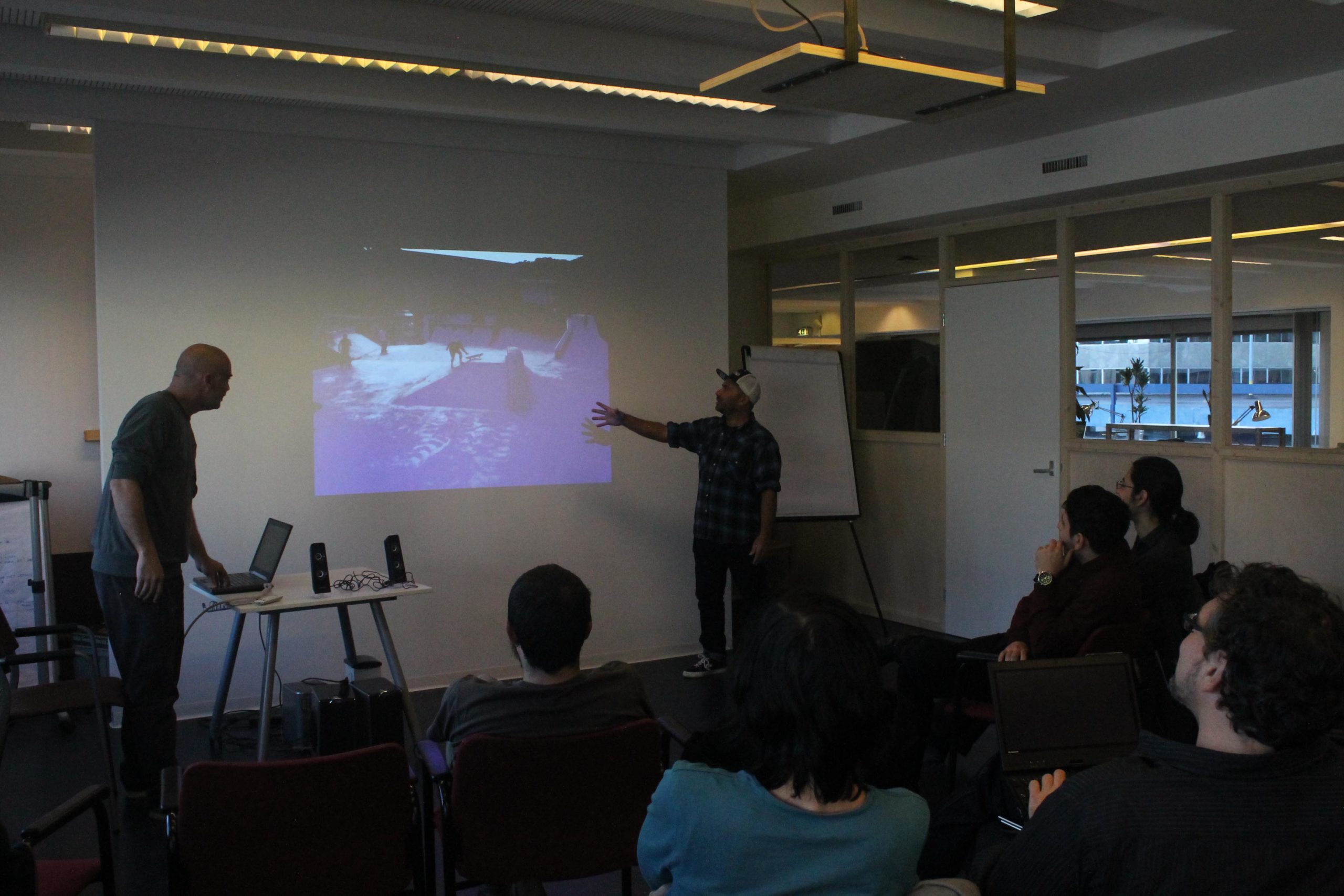
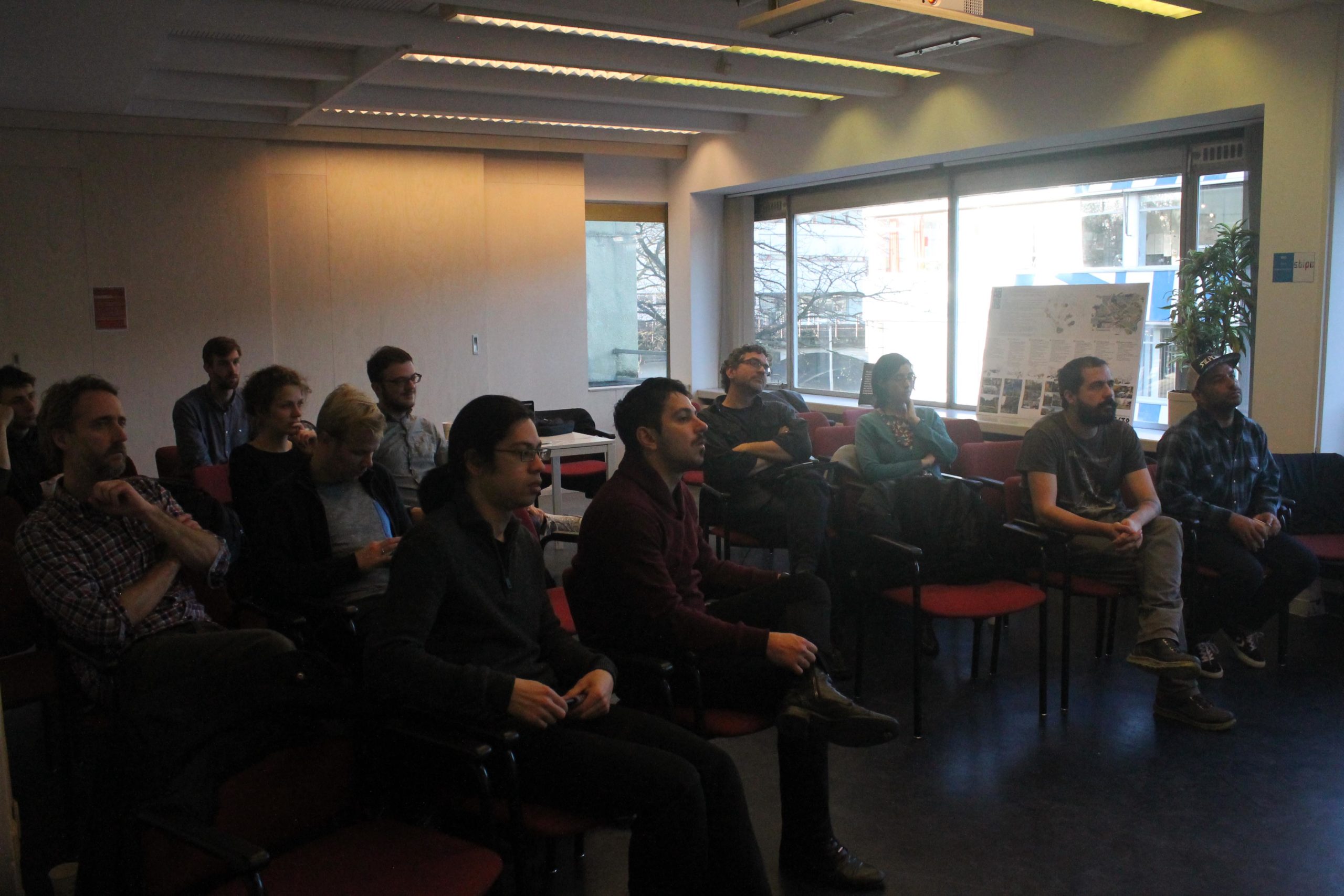
The last talk from this part of the event focused on PublicSpace.tools platform. David together with Ale revealed some specific details concerning the functions and capabilities of the platform combined with examples of how to collect data and use the platform to update it. With this the first part of the event ended and the participants had their time to take a break, enjoy the provided lunch and prepare for the public space safari.
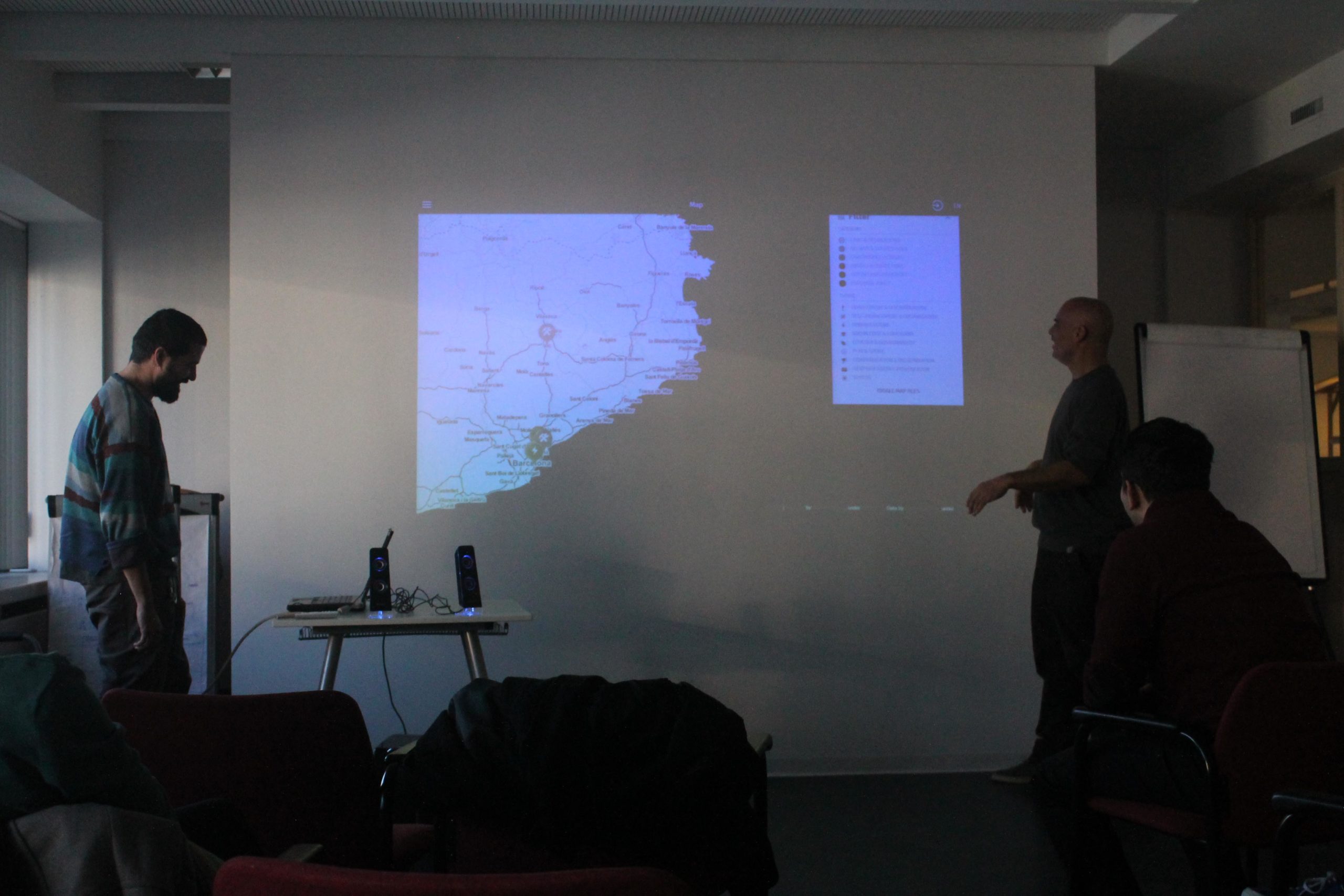
Public Space Safari
After the break the event included a group public space safari which was led by Niels van der Zwam, a developer and skater who is well-familiar with the context of Rotterdam. The safari included a number of spots that are meaningful for the skating scene in the city. Some of them are designed especially for skating but other spots did not have a pre-determined intention of including skaters as intensive users of the place(s). A full description of the safari you can find here.
The places included in the safari were artwork and historic spots such as ‘Delftse Poort’, the City Hall’s bunker, the embankment of the Westersingel and heavy used public spaces such as De Lijnbaan (shopping street), the recently redeveloped Binnenwegplein and the new plaza in front of the Central Station. These spots have completely different purpose but reasons such as their spatial arrangement, surfaces and design elements have attracted special attention by the skaters. Despite the monumental value and meaning of some spots the skaters are not regularly engaged by the police.
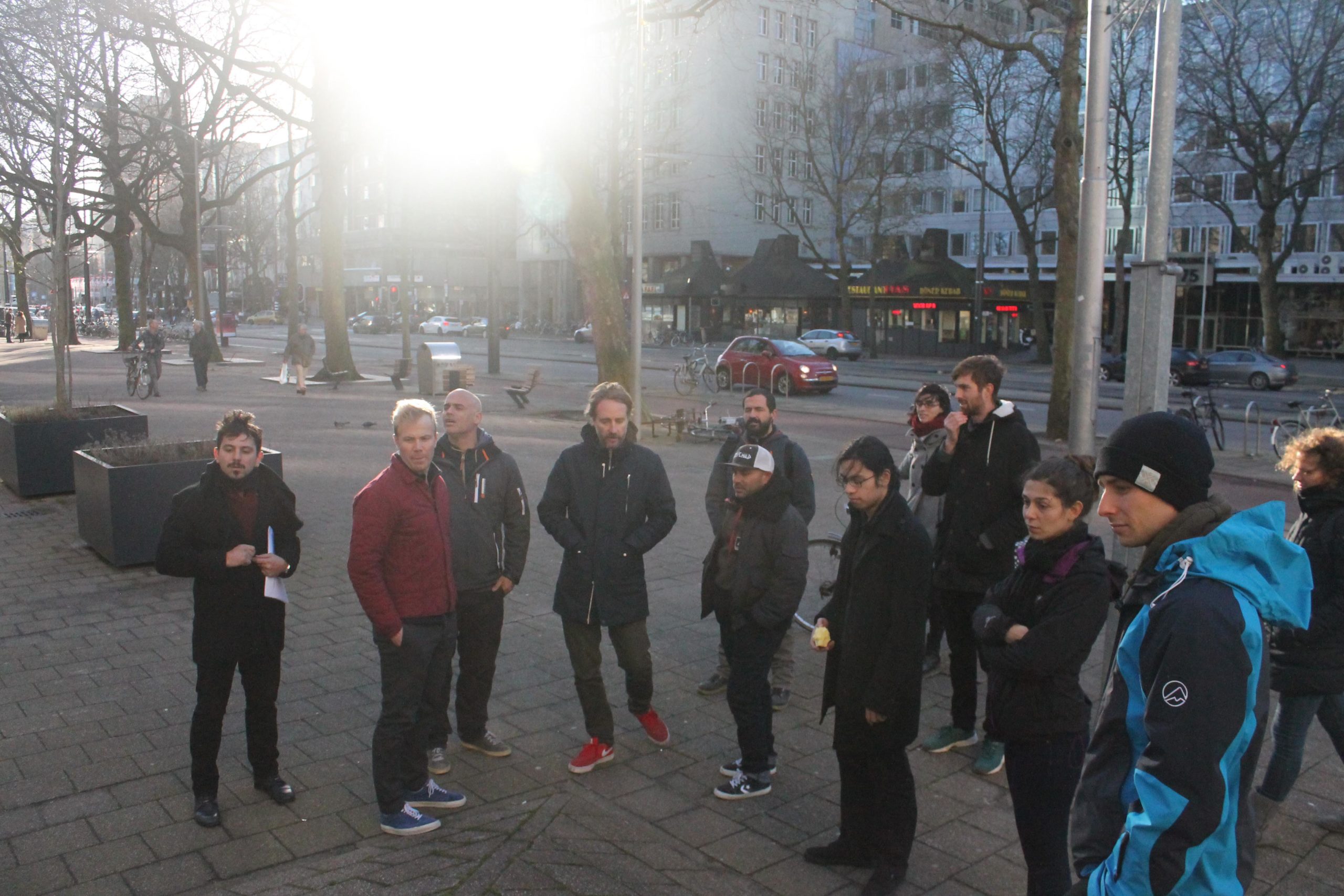
During the walk the participants had the possibility of visiting two places which were design especially for skating – the Westblaak skatepark and the Waterplein by De Urbanisten in the Agniesebuurt. The former location is a famous project in terms of the European skating scene and it is in its final stage of construction. On the other hand, at the Waterplein the possibilities for skating are provided in an informal way.
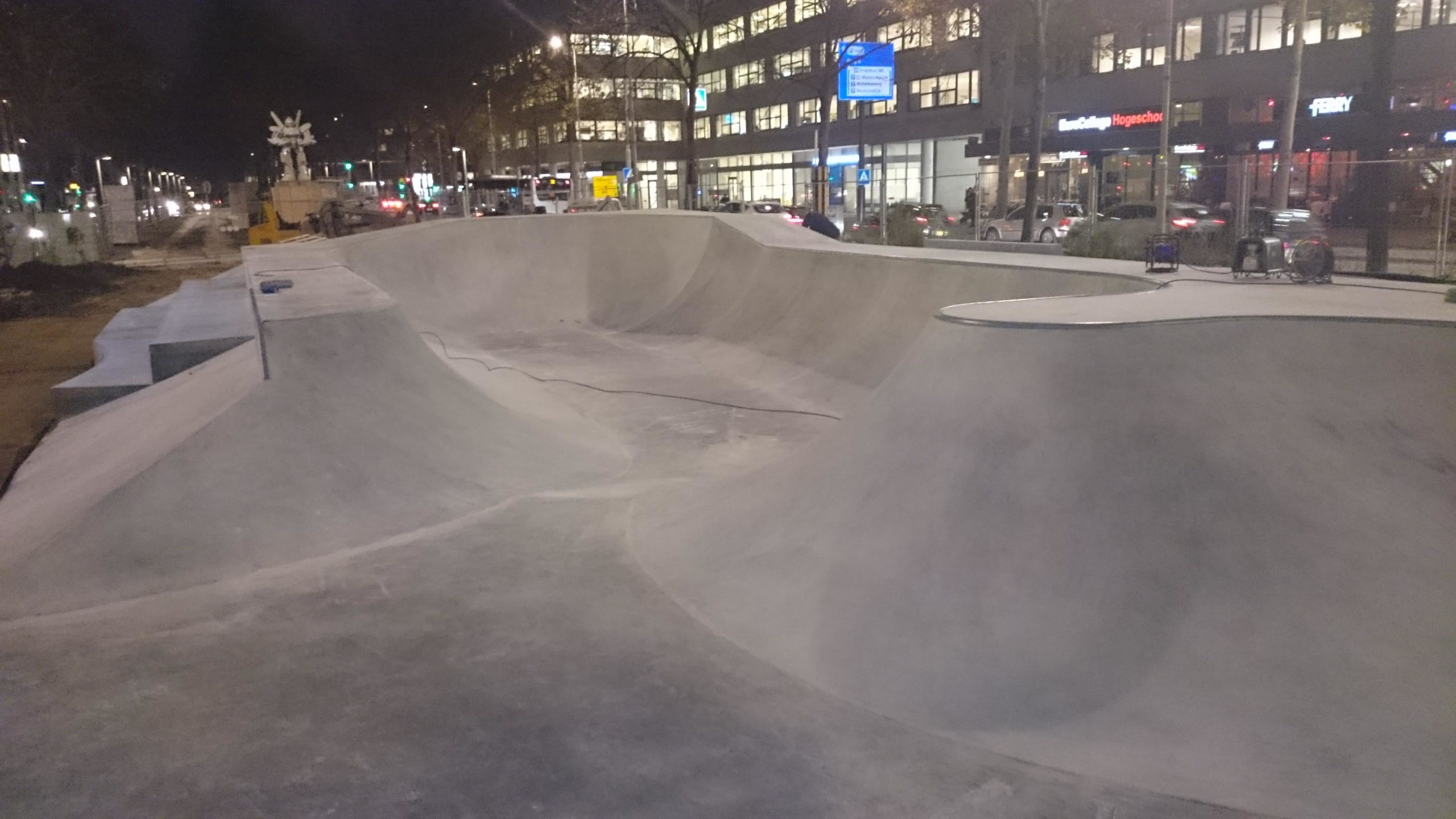
It is worth mentioning that during the public space safari some test uses of the PST mobile app were made in order to test the capabilities of the app in real time.
After the two hours walk in the city the public safari was rounded up and the participants got back to the host location of the workshop where the last stage of the event took place.
Practical Part
The last part of the event contained the practical exercises concerning the event. First, a legal exercise regarding the general behaviour and urban sports in public space was executed. Questionnaires with set of questions were given to the participants with legal questions to be filled up. On the basis of this a discussion on the legal issues in respect of the theme(s) of interest was facilitated.
The closing stage of the event was dedicated on testing and working on the platform. The participants were separated in two groups aiming to prepare content to be uploaded on the platform online. The first group focused on describing the public space safari in a great detail including specific description(s) of the visited spots. The post can be seen here.
On the other hand, the second group worked upon the preparation of content related to the executed legal exercise. They focused more on the organisation of the content into a visual expression. In any case, this content represents in full extent the ‘how-to’, normatively practical input which PublicSpace.tools aims to deliver for its users.
During the exercises couple of informal discussions raised in between the participants addressing the functionality and the capabilities of the platform. With this exercise the workshop came to an end. To sum up, the various activities that took place during the event provided the participants with a mixture of experiences. In result of this multiple informal connections were created which formed the basis for very fruitful knowledge generation and exchange. This was considered as the high appreciated positive that every participant was able to benefit from and hopefully build upon in future professional projects.
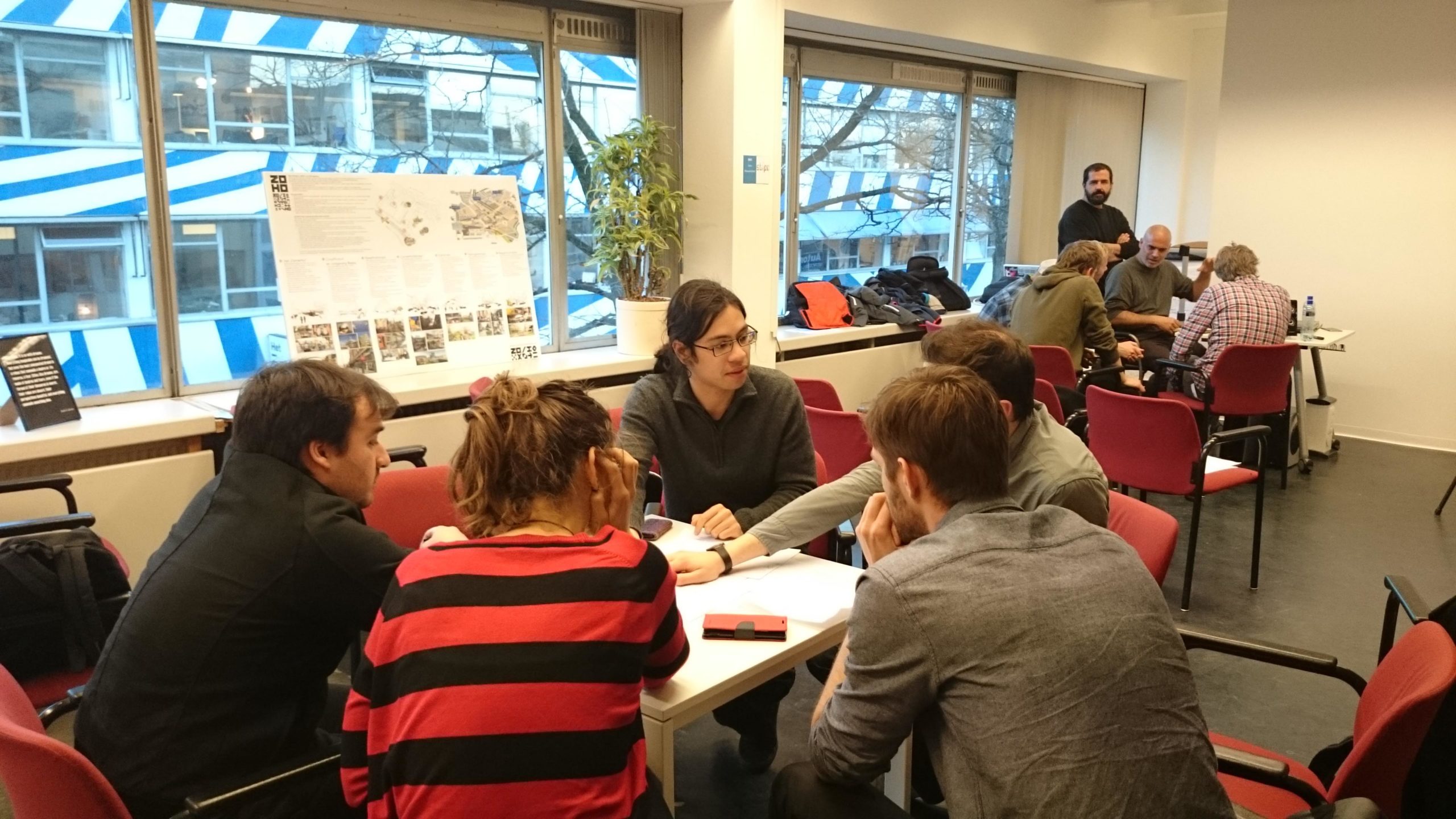
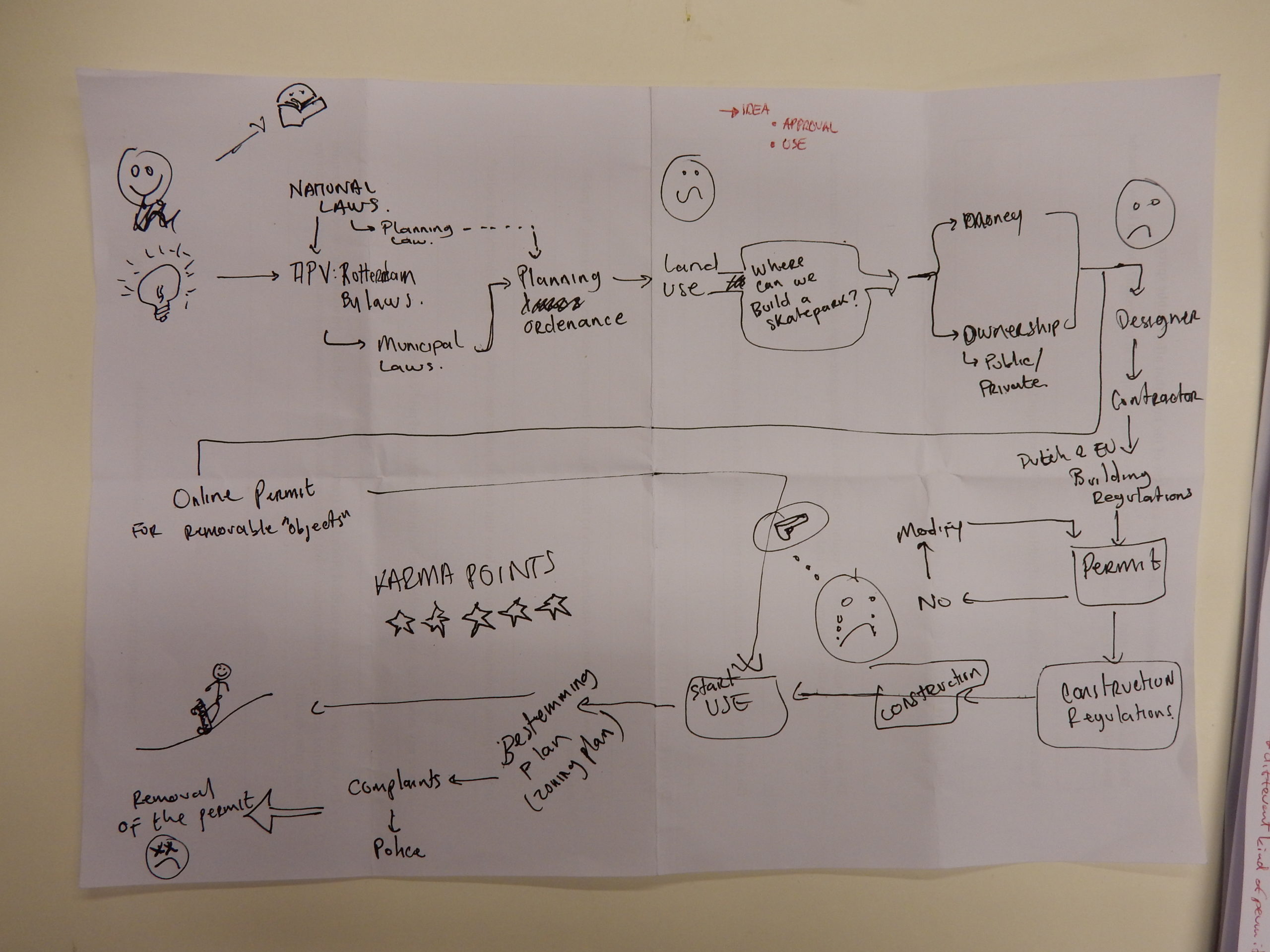
Related links:
Public Space Tools @ Sofia (31|10 – 01|11)
The citizen empowerment for interventions in public space is a theme that it is for quite a while within the discourse of urban development (planning, design and architecture). However, within the context of Bulgaria until very recently this topic has been neglected. The reasons for that can be traced back in the long tradition of dealing with urban development and any other structural issues through utilitarian highly top-down approaches.
In order to deal with the necessities for research regarding this theme in the Bulgarian context, on 31 October and 1 November it has been organised a two-day workshop focused on the Public Space Tools platform. The event was held in Studio “Projectirane” at the University of Architecture, Civil Engineering and Geodesy (UACEG, Sofia). From Bulgarian side the organisation of the event was executed by the association “|IN|Formal” while the local sponsors of the workshop were the architecture / urbanism offices “ATEK” and “Urbika”.
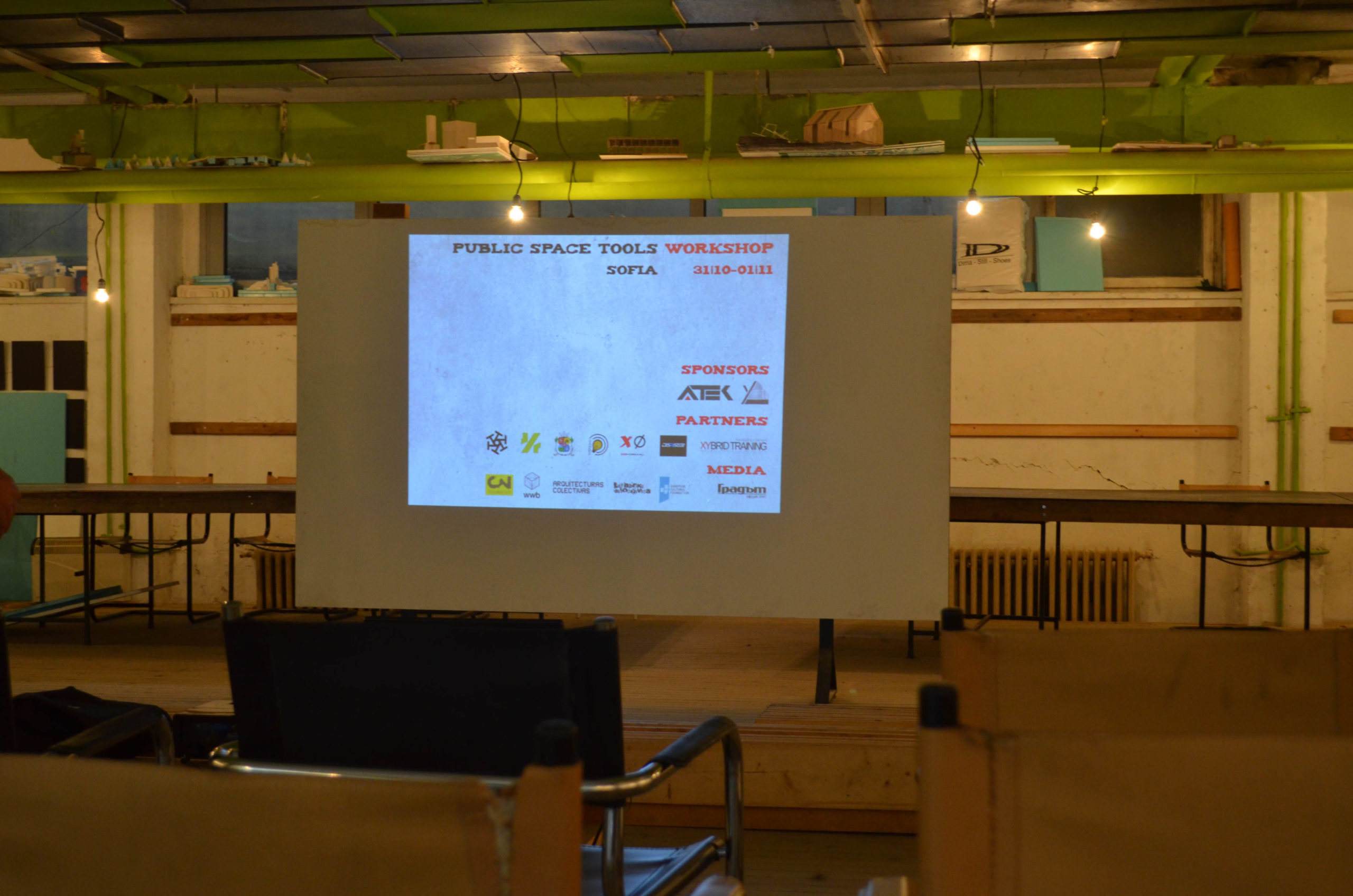
Apart from professionals and student within the sphere of architecture and urban design the event was also visited by civil activists, being experts in other socio-economic domains. Indeed, the collection of such a mixture of interested people was one of the major goals of the workshop. This environment provided possibilities for the creation of various and unusual professional connections with an intriguing potential directed to interventions in the urban space. The workshop was specifically focused on the theme of urban sports and more precisely, on urban fitness and skating. These two activities seem to have a direct relationship with the public space, the empowerment of citizens and legal issue. At the same time the theme itself allow the event to go in certain direction and provide some useful, at least modest, inputs for the platform.
For the purpose of the workshop the schedule each one of the two days was organised in a specific way. The first day was mainly consisted of interactive presentations which aimed to provide the participants with the possibility of getting familiar and exchange knowledge between them. During the second day the technical and practical part of the workshop took part. Respectively, some exercises with the online platform were executed.
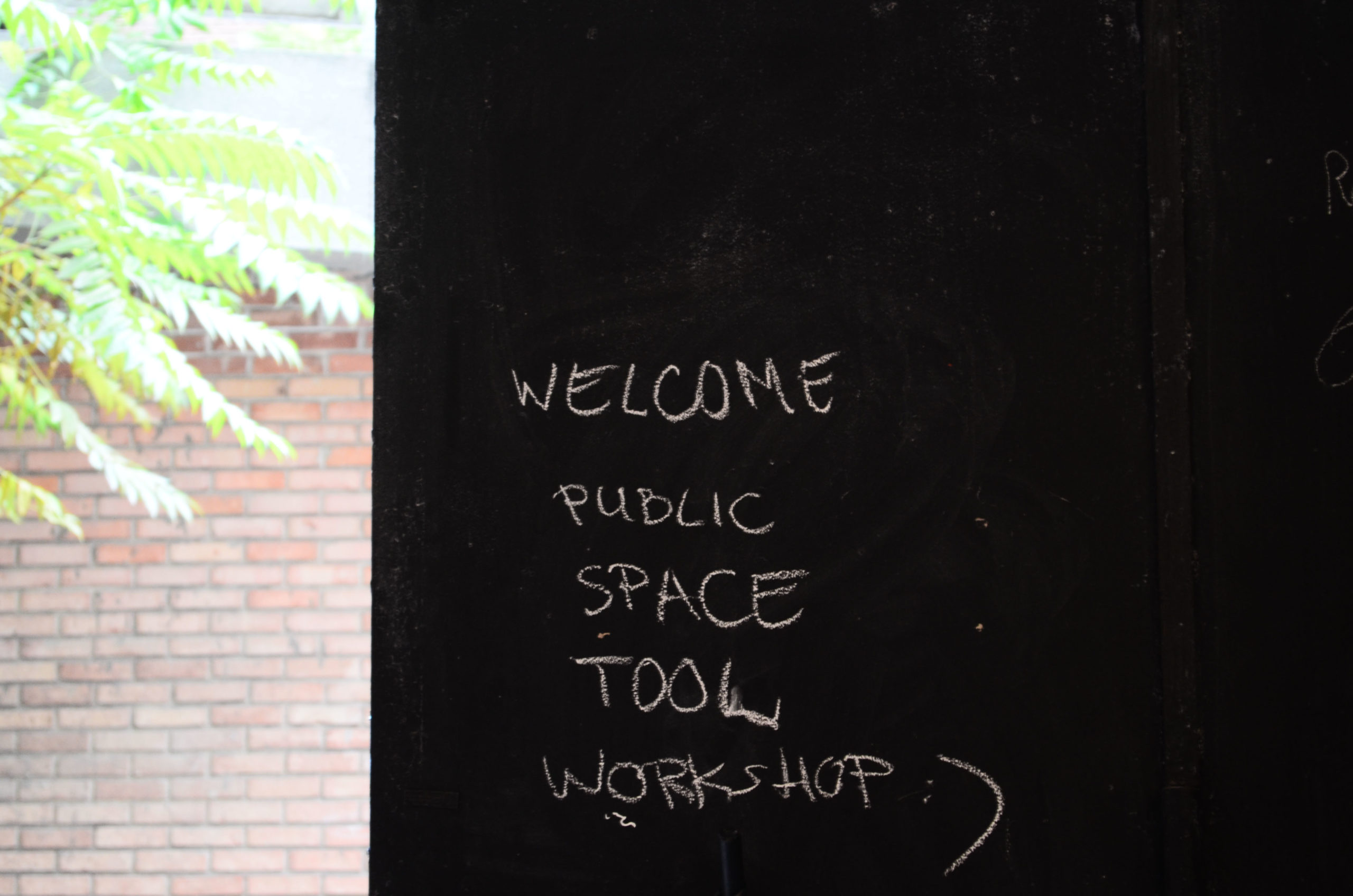
Day I | Saturday – 31.10 | Presentational Part
The first day was consisted of a series of presentation which aimed to contextualise the platform within the “right to the city” concept and the Bulgarian context. For achieving the latter goal multiple local professionals with an experience concerning unconventional urban transformations were invited. In addition, there were also presenters who shared their specific academic and legal knowledge in the field of public space as well as sport experts.
The full list of presenters is:
- David Juarez (Straddle3);
- Rossina Shatarova (Studio Projectirane);
- Valeri Gyurov (Transformatori);
- Emil Mihov & Teodora Trifonova (POdLEZNO);
- Tanya Prodanova & Martina Nenova (Architectural and Urban Spatial Development Service, Municipality of Sofia);
- Ivan Germanov (Urban Fitness – XYBRID Training);
- Georgi Spasov (Urban Skating – AISA Disaster).
The kick-off of the event was made by David Juarez, who is co-founder of Straddle3 and one of main initiators behind the PublicSpace.tools project. He introduced the participants into the theme of public space essence, its dynamics, specifics of the various uses, the “right to city” concept and legal issues in respect to it. David also made a short introduction of the PublicSpace.tools platform which was further elaborated in a later stage of the day.
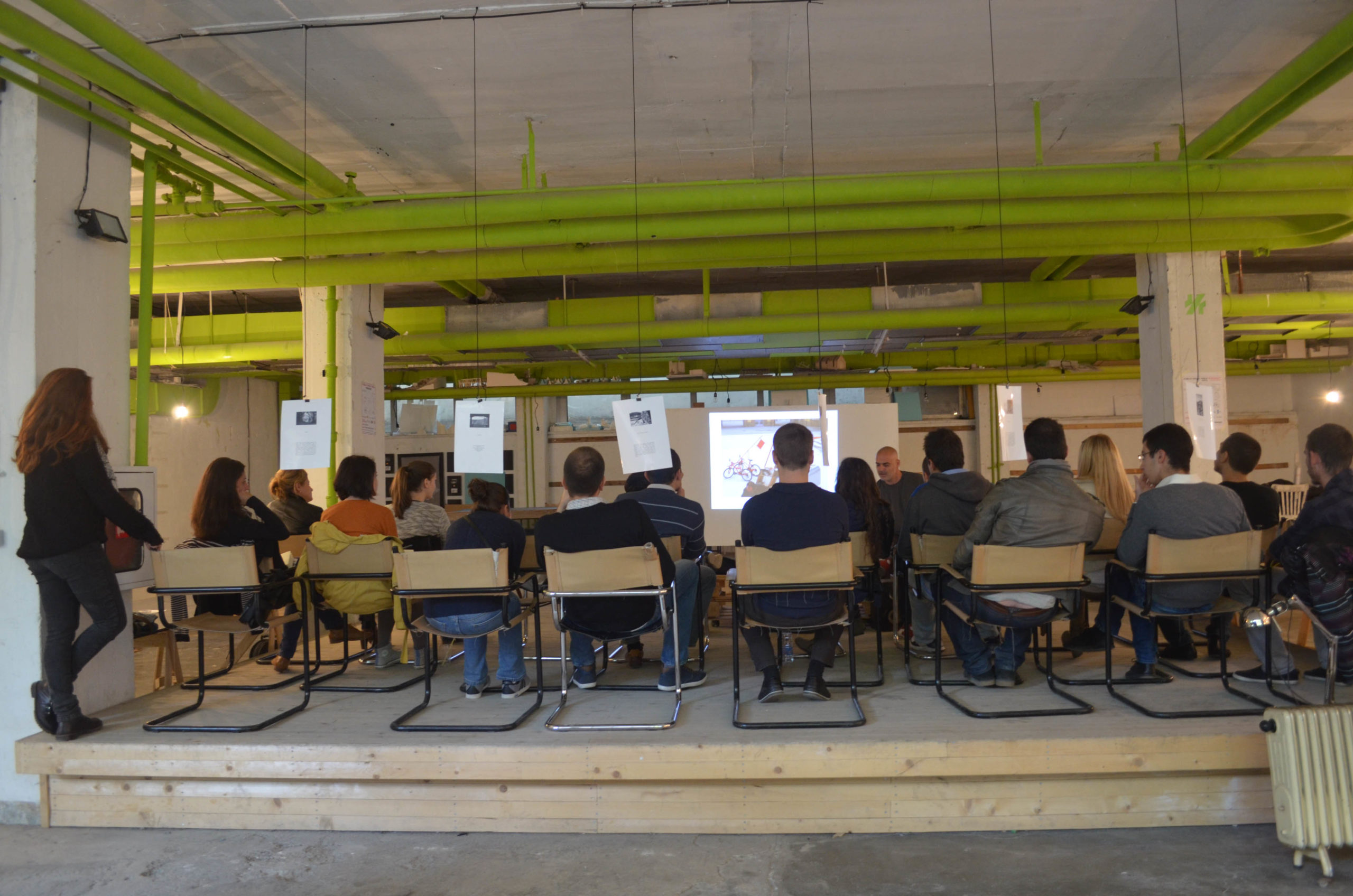
The next three presentations focused on the Bulgarian context including some intriguing examples of unconventional, bottom-up public space interventions. The first one was made by Rossina Shatarova (Studio Projectirane), who showed her point of view about the alternative ways of exploring and interacting with the public space as a way of professional education. She was followed by Valeri Gyurov, of the co-founder of Transformatori association, who presented part of their successful project and shared his experience in initiating civil engagement and participation in the urban transformational process. Emil Mihov and Teodora Trifonova (POdLEZNO) also shared their view by making a detailed overview of their physical interactions with public space in Sofia. In addition, Emil and Teodora made an interesting transition towards the following talks during the event i.e. legal frameworks within which the various types of interventions in the urban environment took place.
Indeed, the next presentation was made by Tanya Prodanova and Martina Nenova by taking their role as experts at the Architectural and Urban Spatial Development Service (AUSDS) within the structure of the municipality of Sofia. They revealed more concrete details concerning the different definitions, regulative zones and legal possibilities for public space interventions outlined by the normative documents and acts. What is more, Tanya and Martina also paid substantial attention on the required documentation and the administrative procedures which can guide and ease the physical interventions within the urban environment.
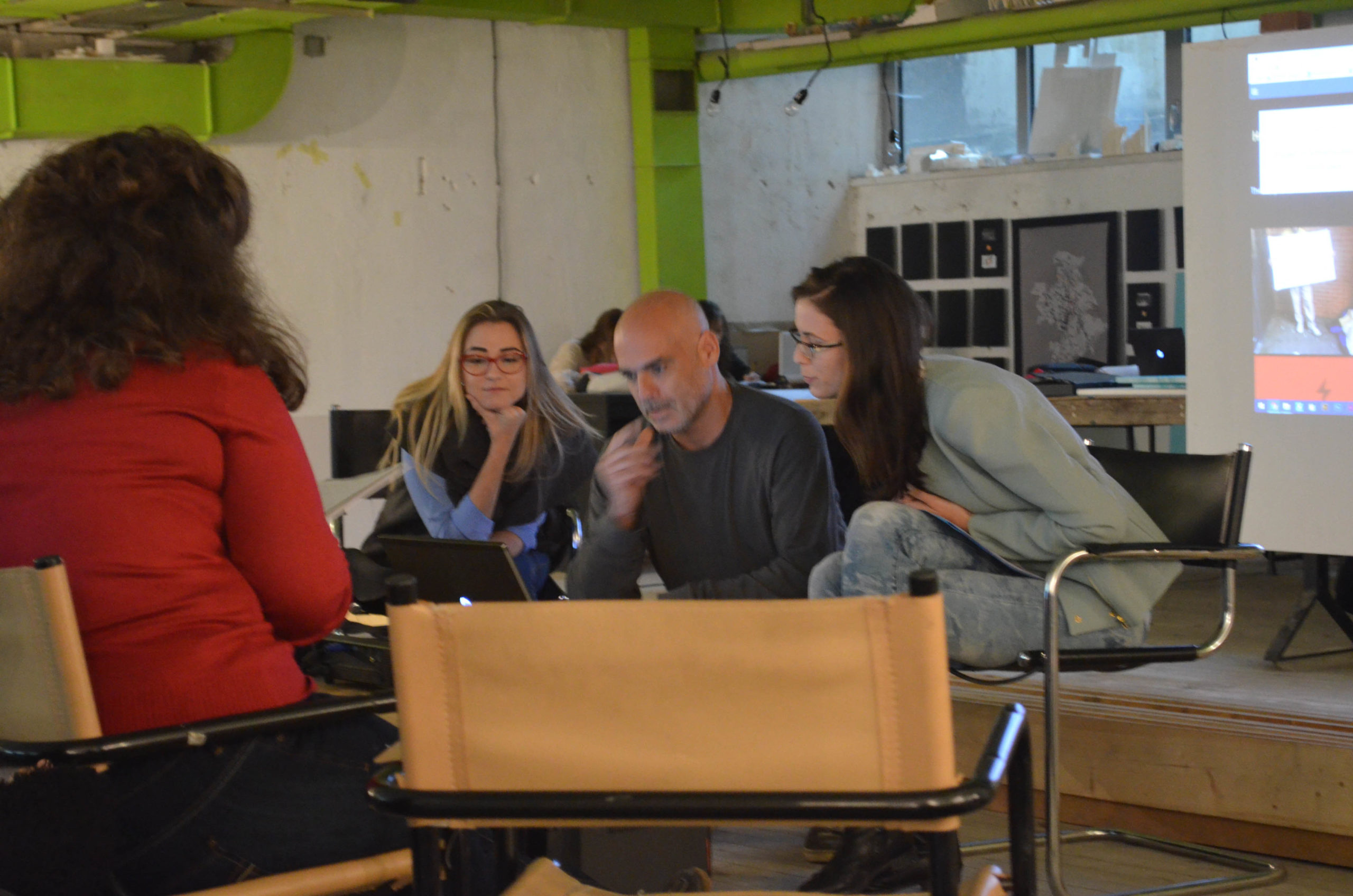
After a scheduled lunch break the last two presentations took place. They provided a slightly different and intriguing interpretation of major theme of interest i.e. the public space. The talks were led by two experts in the field of urban sports – Ivan Germanov (Urban Fitness) and Georgi Spasov (Urban Skating) who presented the perspective of the sport enthusiast within the urban environment. The interesting part was determined by the part that both Ivan and Georgi concluded with statements about public space that are generally well-accepted also by the professional and academic field of urbanism and architecture.
The last talks were followed by a debate on the themes which were discussed during the whole presentational day. As an epilogue of the first day some more specific details concerning the functions and capabilities of the PublicSpace.tools platform were made combined with examples of how to collect data and use the platform to update it. With this the first day of the event ended and the participants had their time to make a short fieldwork to gather impressions and ideas on the basis of which can use the platform on the second day of the workshop.
Day II | Sunday – 01.11 | Practical Part
The second day of the event continued from the point where the first one finished. After the theme of the citizens’ empowerment was defined in contextual, conceptual, professional and legal terms the second part of the workshop focused on the technical and practical exploration of the PublicSpace.tools platform.
Since the platform was a project which in beta version at the time of the event it was aimed the participants to exercise and test its functionality. By doing so and respectively reflect on their user experience they contributed to the further technical development of the toolkit. Despite this, the participants were provided with a log-in access through which they had the possibility to explore the added content. What is more, after being granted with an individual access they could prioritise certain part of the general content in respect to their specific context and interest.
During the exercises all details of the platform including technology, structure, functionality and types of content were reviewed. In the span of few hours the numerous possibilities for the platform’s enhancement were discussed in a form of informal discussion by the various professionals who were present – architects, urban designers, computer specialists and sport enthusiasts. In addition, the participants shared their view upon how the platform can be useful in achieving different goals.
In general, the presented content during the event and the created setting provided a quite fertile environment for knowledge exchange. In these terms the workshop was highly evaluated by the visitors who took part. The mixture of presented information certainly granted the workshop guests with an intriguing opportunity to enrich their knowledge regarding the theme of citizen empowerment and the “right to the city” concept. Moreover, the numerous professional relationships which occurred during the workshop were positives that might have a long-term impact and optimistic prerequisite concerning further development of the thematic research and the actual application of the PublicSpace.tools platform in Bulgarian context.
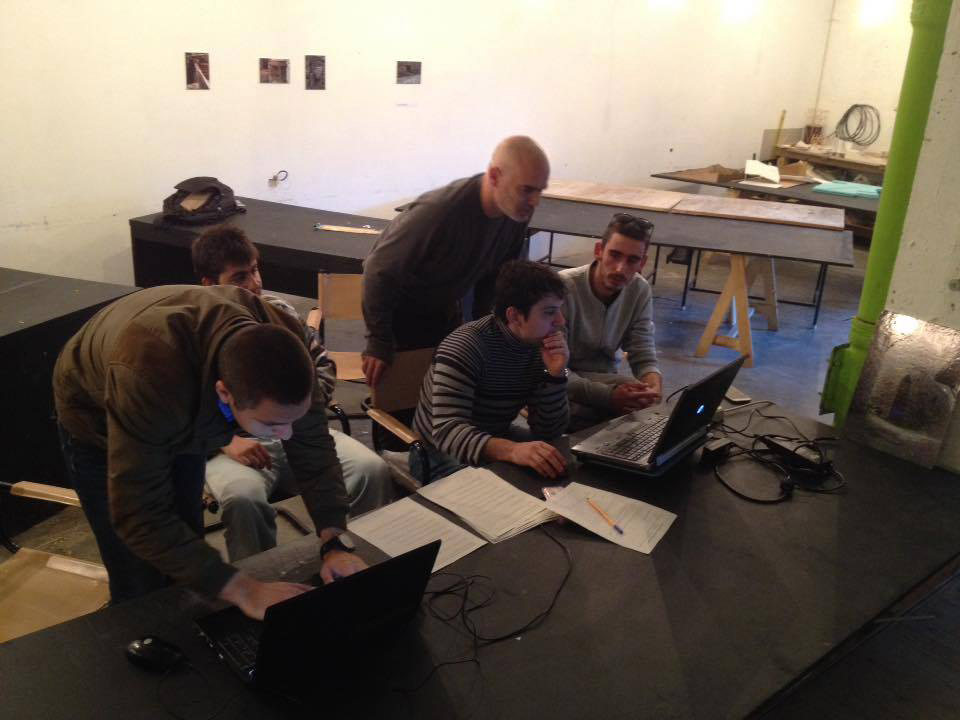
Related links:
- publicspace.tools/#/posts/285
- publicspace.tools/#/posts/286
- publicspace.tools/#/posts/290
8th Arquitecturas Colectivas International Meeting in Extremadura
Last summer, Erku and David invited me to visit Los Santos de Maimona, a small town in the autonomous community of Extremadura in western Spain, very close to the Portuguese border, for this year’s annual meeting of the Arquitecturas Colectivas (AACC) network.
AACC is a network of people and projects that are actively involved in participatory creation of the urban environment. The aim of the network is to connect different factors that strongly influence urbanisation processes, in order to develop anthropogenic habitats that are characterised by special circumstances, and the communities that live in them. AACC is a complex network that combines practical and construction techniques with more social, cultural and technological aspects of urban contexts.
More specifically, AACC offers an organic framework for cooperation that can be divided into different types of projects and initiatives. It does this principally in three ways:
– Through face-to-face meetings for sharing experiences, workshops, and prototypes,
– Through the Internet and other systems of digital communication,
– Through projects / collaboration processes (analysing and producing works, cooperation and support of participatory processes, resources, pooling of experiences, and mutual support).
The theme of this year’s international meeting, which took place from 9 to 13 September, revolved around the participatory restructuring of urban space. The meeting brought together over 20 collectives and some two hundred people from around Spain, Europe, and Latin America, all involved with diverse practices concerning public matters and the commons.
The slogan of the meeting was “Pork in Progress”, a play on words on many levels inspired, on one hand, by pigs and pig farming, a major industry in the region and one of the most representative symbols of the collective imaginary of Extremadura, and, on the other, the idea of “work in progress” one of the ideas underpinning AACC as a network that is alive, changing, permeable and in constant organic growth.
The meeting took place at LaFábrika detodalavida (LFdTV), a self-managed social laboratory for the management of space, free time, and rural culture that generates cooperative practices based on the philosophies of free culture and the commons. The premises, which are a former cement factory on 40,000 square metres of public land, had been abandoned since 1974 until the LFdTV collective decided to reappropriate it as a self-managed cultural centre.
A pressing task for citizens today is to generate structures that promote cultural management based on an open source philosophy, bypassing entities that do not share those principles and do not have the capacity to adapt to the needs and conditions of the specific space. Self-management as a political act. The AACC meeting was in line with this mission and philosophy, and also aimed to more broadly highlight the needs and priority of citizens, and to promote good practices and strategies that ensure a more participatory society.
Our participation at the AACC meeting was linked to the presentation of the project PublicSpace.Tools (PST), developed by Straddle3 and WWB as a tool for citizen emancipation through critical, creative, and non-conventional applications. During the meeting, the team also worked on expanding and improving the functionality of the AACC website (arquitecturascolectivas.net)
The PST workshop presented guidelines for the activation of public space through the PublicSpace.Tools project that the team has been developing over the past year as an open platform. It is part of a strategy of generating new tools for participatory reconstruction of the urban environment within the AACC community and its philosophy.
I was invited to the meeting to talk about recent developments in Greece in relation to citizen use of public space (as from the start of public works in the lead up to the 2004 Olympic Games in Athens), with a particular focus on parks and green spaces with high levels of vegetation, and about the self-management of these places. At the same time, I had the opportunity to produce a photographic report of the meeting. The debate that followed my presentation showed the shared interest in updating the concept of the Agora – which was the heart of public life in cities in Classical times – for the present.
The AACC meeting was free and open, and its main objective was to share and exchange ideas among participants, with a view to promoting the participatory, collaborative remodelling of the urban environment in all its aspects, through contributions from sociologists, anthropologists, activists, educators, social and cultural managers, landscape designers, environmentalists, urbanists, technology professionals and many others who form part of the community.
Many of the objectives of the organisers were met, including:
– To promote the town of Los Santos de Maimona (including its landscape, peculiarities, culture, and gastronomy) and the region of Extremadura in general, which can be considered peripheral in relation to the administrative centres of Spain.
– To support LaFábrika detodalavida and its structures and processes, as a benchmark project for the recovery of the heritage value of neglected or abandoned public spaces and facilities.
– To explore, reinforce, and publicise some of the collaborative practices that take place in the Extremadura region, so that they can connect to other similar processes/projects at the international level.
This year’s AACC meeting was special in that it strengthened the identity of people and projects in rural areas through collective, creative actions. In short, it showed how people can directly generate self-management processes that contribute to the governance of towns and cities: projects and actions in which people collaborate through collective activities that shape their environment, improve their lives, and, as a result expand and enhance social and economic relations.
At the final assembly, it was collectively decided that the 2016 AACC meeting will take place in the periphery of Madrid, a city very dear to me.
Public Space Uses and Hacks, PST and P2P Plazas at Medialab Prado
Public Space Uses and Hacks: tools for collective maps of unforeseen actions
Location: LAB at Medialab Prado
A debate on boundaries that apply to the use of public space in relation to initiatives based on developing tools and communal spaces for unforeseen actions and for the expression of citizen demands.
Introduction
“All citizens have the obligation to use the city’s public spaces, services, facilities, and urban furniture, and other elements, correctly and in accordance with their nature, intention and purpose, always respecting the rights of other citizens to use and enjoy them.”
Paragraphs like these can be found in the municipal by-laws of any of our cities. This particular one is taken from the Barcelona municipal by-laws. Nonetheless, the idea that there is a “correct” way to use public space is not in line with real urban practices, or habitual ways of living in the city, or with the needs of different groups, individuals, moments in time, situations…
Language is not innocent, and the idea of a supposedly “correct” use of public space gives rise to a long list of unforeseen actions that citizens engage in and that could potentially lead to sanctions. The phrasing also reflects the increasing standardisation and privatisation of common spaces. But in response to these same boundaries, many initiatives try to go beyond the limits, to provide tools for the collaborative construction of shared gathering places and to create environments in which to support and sustain legitimate claims.

PublicSpace.Tools
PublicSpace.Tools is a tool developed by Straddle3 (Barcelona) to promote citizen empowerment for critical, creative, or unconventional uses of public space.
PublicSpace.Tools is a multilingual online platform that is still in development stage. It consists of two elements: 1) an interactive platform based on open source software that includes a map of posts created by users, with information on legal regulations pertaining to public space, good practices, recipes and tips, the reporting of abuses, etcetera; 2) a mobile application linked to a geolocalisation interface that allows users to publish content in real time.

P2P Plazas
P2P Plazas, a Southern European Network, is a research project carried out by Carmen Lozano Bright (Madrid), that is presented in tandem with PublicSpace.Tools at MediaLab. P2P Plazas was presented at MediaLab on 7 April 2015 as part of Open Conversation: Maps of the Commons in Public Space. The project now returns to MediaLab to present some of the common characteristics found in the study of three different spaces: Patio Maravillas (Madrid), La Casa Invisible (Malaga) and Navarinou park (Athens) with the aim of defining certain tools that can be useful for connecting community spaces which are cared for and self-managed by users.

The objectives of the MediaLab workshop are:
– To contextualise PublicSpace.Tools within the concept of the right to the city, in relation to specific matters regarding public space in different European cities.
– To analyse the legal conditions that apply to public space, and how to deal with them when planning and implementing unconventional activities.
– To provide basic technical and conceptual information to participants, allowing them to appropriate the tool and use it for their own objectives.
– To explore the possibilities for interaction between the platform PublicSpace.Tools and the P2P Plazas research project.




